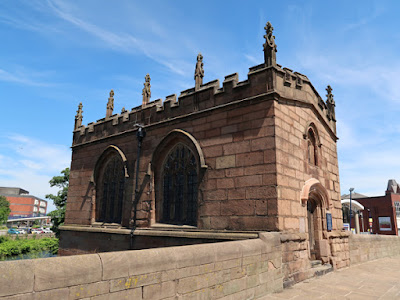 |
| Damage caused by vegetation at St. Stephen's church |
My walk from Wentworth to Elsecar and back took much less time than I thought it would and I was back in Rotherham by 1:15 pm. With the sun still shining, I decided to go and photograph the former Rotherham School Board buildings on St. Leonard’s Road – a task that I had tried to undertake 3 weeks earlier, during my last trip to Rotherham, but had to cancel due to the rain.
Just before arriving at Rotherham Bus Station, however, I had noticed that some repairs had been undertaken to the Chapel of Our Lady on the Bridge, the first restoration project anywhere that I was aware of since I was told that Rotherham Red sandstone was no longer available, and I went to have a quick look at these first.
As a geologist with specialist expertise in the identification and matching of building stones, first acquired when working in the building restoration industry in London, I had my own ideas on what stone would be suitable for restoration work for buildings constructed in Rotherham Red sandstone – as demonstrated by a stone matching exercise that I undertook earlier in the year in Treeton.
St. Bees sandstone, which has been used for the new hood mould and label stops above the entrance door, was on my shortlist of samples and has been used for very small repairs on the old town hall in Rotherham; however, although it is not a bad match for the Rotherham Red sandstone here when dry, which is quite red in colour, it appears that red sand has not been used to tone down the colour of the lime mortar.
Making my way to St. Leonard’s Road, the corner site with St. Ann's Road is occupied by the boys’ department of the former St. Ann’s Road Board School, which was completed in 1893 to the design of Henry Louis Tacon – a Rotherham architect that I had never heard of, but who was also responsible for some of the better quality buildings in the town centre.
The building was last occupied 20 years ago, as an annexe to Rotherham College of Art and Technology and, not being a listed building, it is very surprising that it is still standing, given that most of Rotherham’s board schools have been demolished and Rotherham MBC does not seem to place much value on its historic architecture.
A little further up St. Leonard’s Road, an extension for girls and infants was added not long after, increasing the number of places from 244 to 761 children. Again, it is not listed, but since 1980 it was converted into the Unity Centre, a multi-purpose community resource.
I didn’t stop to look at the stonework in any detail but, as with the Alma Road Board School, it is not built in Rotherham Red sandstone nor does it look like any of the other Coal Measures sandstones that I have seen used in the Rotherham area and would need further investigation.
Retracing my steps to St. Ann’s Road, I stopped to take some photos of the Grade II Listed former St. Stephen’s church, which is built in Rotherham Red sandstone and was completed in 1874, with a Gothic Revival design by T. D. Barry and Sons of Liverpool.
To my eye, its most interesting features are the grotesques on the tower and the deteriorating condition of the parapet and its associated weathering and drainage details, with widespread efflorescence on the surface reflecting water ingress and damage caused by a substantial root/stem forcing open a joint in the masonry.










No comments:
Post a Comment